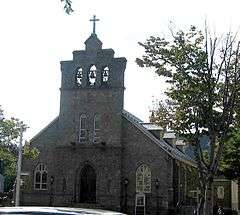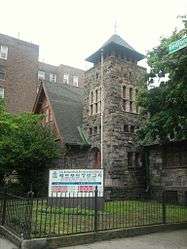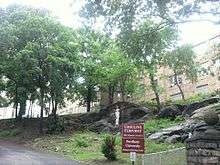Bedford Park, Bronx
| Bedford Park | |
|---|---|
| Neighborhood of The Bronx | |
|
View of Mosholu Parkway in the Bronx | |
|
Bedford Park  Bedford Park  Bedford Park  Bedford Park Location of Bedford Park | |
| Coordinates: 40°52′12″N 73°53′08″W / 40.8700999°N 73.8856912°WCoordinates: 40°52′12″N 73°53′08″W / 40.8700999°N 73.8856912°W | |
| Country |
|
| State |
|
| City |
|
| Borough |
|
| Area[1] | |
| • Total | 1.18 km2 (0.455 sq mi) |
| Population (2011)[1] | |
| • Total | 37,344 |
| • Density | 32,000/km2 (82,000/sq mi) |
| Economics | |
| • Median income | $29,856 |
| ZIP codes | 10458, 10468 |
| Area code | 718, 347, 646 |
Bedford Park is a residential neighborhood in the northwest Bronx between the New York Botanical Garden and Lehman College. The neighborhood is part of Bronx Community Board 7.[2] Its boundaries, starting from the north and moving clockwise are: Mosholu Parkway to the north, Webster Avenue to the east, East 198th Street to the south, and Goulden Avenue to the west. The Grand Concourse is the primary thoroughfare through Bedford Park. The IND Concourse and IRT Jerome Avenue Lines of the New York City Subway serve the area. Zip codes include 10458 and 10468. The area is patrolled by the 52nd Precinct located at 3016 Webster Ave in the Norwood section of the Bronx.
History
The area now known as Bedford Park was mostly farmland outside the town of Kingsbridge, then an unincorporated suburb of New York City. The area began to be developed with the construction of the Jerome Park Racecourse, for thoroughbred horse racing, by Leonard Jerome and August Belmont, Sr. in 1866. Jerome Park Racecourse became the first home of the famous Belmont Stakes horse race, until 1890. To attract the wealthy to the racecourse, Leonard Jerome built what is today Jerome Avenue. In 1874 the town of Kingsbridge was officially incorporated into New York City.[3][4]
In 1890, Jerome Park Racecourse was sold. Construction was started to convert it into the Jerome Park Reservoir, to store fresh water from the New Croton Aqueduct. At the same time, the neighborhood of Bedford Park was beginning to take shape. Forty "villas" (suburban houses) were built on a 23-acre (93,000 m2) stretch, in a planned community, named Villa Avenue.[4]
The area became a part of the newly created Borough of the Bronx in 1898. The Italian and Irish immigrants who worked on the Jerome Park Reservoir project soon anchored the community there. In 1906, 200th Street was renamed Bedford Park Boulevard, likely named after Edward Thomas Bedford, a director of Standard Oil, president of the Bank of the State of New York, who was an associate of Leonard Jerome.[4]
Development continued with the completion of the Grand Concourse, a multilane thoroughfare, in 1914; and the extension of subway to the area with the IRT Jerome Avenue Line in 1917. The Grand Concourse saw a boom in housing construction in the post-World War I era.[3] Much of this was from middle-class (primarily Jews, Italians, and Irish) moving from Manhattan.[4]
Land use and terrain
Bedford Park is dominated by 5 or 6-story apartment buildings and three-story Victorian houses. The apartments on the Grand Concourse are often taller. Tracey Towers are two 41-story subsidized apartment buildings built close to the Jerome Park Reservoir. Designed by noted architect Paul Rudolph, they were completed in 1972 as a part of New York City's Mitchell Lama housing development initiative. The total land area is a little less than half a square mile.
Demographics
In the United States 2000 Census[5] of 2000, the area of Bedford Park comprises five tracts. These five tracts have a population of 24,874.
The racial makeup of the neighborhood is 60.67% of the population are Hispanic or Latino of any race, 13.5% African American, 17.07% White, and 8.76% from other ethnicities, including Korean, Indians, and Bangladeshis.[3]
Landmarks
Houses of worship


Among Bedford Park's oldest buildings are its churches and other religious institutions. The oldest church in the area, Bedford Park Congregational Church at the corner of Bainbridge Avenue and East 201st Street, dates to 1882. Its American Queen Anne-style design hints at Bedford Park's origin as a small rural community. It was designated a City Landmark in 2000. (New York City Landmarks Commission 2005)
On the Grand Concourse lies the Roman Catholic Church of St. Philip Neri (Bronx, New York). The church was dedicated to the Italian saint due to its origin as a mission church for immigrant Italian laborers, who also worked on the construction of the Jerome Park Reservoir. The cornerstone of the church (dated 1899) was in fact quarried from what became Jerome Park Reservoir, and brought there by a horse-drawn carriage. (Greene 2002) When built and for many years thereafter, this parish served a nearly entirely Italian congregation. This parish also is unusual in being an Italian National Parish that was founded and largely served by non-Italian (Irish) clergy. On June 13, 1997, the church suffered a massive fire, and was given major renovation into the mid-2000s.
Educational Mile

The Convent of Mount St. Ursula is located on Bedford Park Boulevard and Bainbridge Avenue.[6] It was established by a group of Roman Catholic nuns from the Ursuline order in 1892. The Academy of Mount St. Ursula High School, an all-girls prep-school, is located there today. It recently celebrated its 150th anniversary with the class of 2005. The academy is now the oldest, all female Catholic school in New York state. In the 1930s, unclaimed land near the Jerome Park Reservoir offered opportunities for New Deal-related construction to alleviate unemployment from the Great Depression.
Three high schools (Walton, DeWitt Clinton, and Bronx Science) were built, along with the Bronx campus of Hunter College (now Lehman College). After end of World War II, in 1946 Hunter College's Bronx Campus served briefly as host of the United Nations. Currently, two of the nine specialized high schools in New York City are in the area, which includes Bronx High School of Science and the High School of American Studies at Lehman College. There was also a small private high school Bedford Park Academy.
Lehman College
Lehman College was originally Hunter College's uptown campus.[7] The Works Progress Administration built the original four buildings of the campus in grey stone in the Collegiate Gothic style, with finials, turrets, and other decorative features. Additional buildings, including the Lehman Library and Center for the Performing Arts, were added in the style of modern architecture. The newest building, the APEX, has facilities for athletics and dance. The scenic campus, which spans into Kingsbridge, has been used as a shooting location for episodes of the television series Law & Order and its spin-offs.
Culture
Reflecting a population so greatly composed of foreign-born immigrants, there are distinct ethnic enclaves in Bedford Park. On 204th Street, between the Grand Concourse and Mosholu Parkway lies a small cluster of Korean restaurants, groceries, social clubs, and other businesses.
Bedford Park's ethnic diversity manifests itself in an assortment of ways besides the formation of enclaves. Among the national symbols one may see strolling the neighborhood include the double-headed eagle (the emblem of Albania), the icon of Our Lady of Guadalupe (sacred to Catholic Mexicans), the shamrock of Ireland, the Arabic calligraphy of the shahadah (the Muslim profession of faith), or the coquí of Puerto Rico. A vast assortment of newspapers are sold in local convenience stores, including The Echo of Ireland, Albanian-language Bota Sot of Kosovo, and the Spanish-language local newspapers El Diario/La Prensa, and El Hoy.
Transportation
- Bx1: to Riverdale or Third Avenue – 138th Street station (6 <6> trains) (via Grand Concourse)
- Bx2: to Kingsbridge Heights or Third Avenue – 138th Street station (6 <6> trains) (via Grand Concourse)
- Bx10: to Riverdale or Norwood – 205th Street station (D train) (via Riverdale Avenue)
- Bx22: to Castle Hill (via Castle Hill Avenue)
- Bx26: to Co-op City (via Allerton Avenue)
- Bx28 / Bx38: to Co-op City or Fordham (via Gun Hill Road)
- Bx34: to Woodlawn or Fordham (via Bainbridge Avenue)
- Bx41 / Bx41 SBS: to Gun Hill Road station (2 5 trains) or Third Avenue – 149th Street station (2 5 trains) (via Webster Avenue)
- Bee-Line Bus 20 and 21: to White Plains, Westchester County (via Jerome Avenue and Central Avenue)
- Bee-Line Bus 4: to Yonkers, Westchester County (via McLean Avenue)
- Bedford Park Boulevard – Lehman College (4 train)
- Mosholu Parkway station (4 train)
- Bedford Park Boulevard station (B D trains)
- Botanical Garden station: (Harlem Line of Metro-North Railroad)
References
- 1 2 "Bedford Park neighborhood in New York". Retrieved 2 November 2015.
- ↑ "Bronx Community District 7" (PDF). Archived from the original (PDF) on 5 March 2016. Retrieved 2 November 2015.
- 1 2 3 LANAHAN, LAWRENCE. "A Friendly Bustle, With Oases Nearby". The New York Times. Retrieved 2 November 2015.
- 1 2 3 4 "Brief History of the Norwood, Bedford Park & Kingsbridge Heights" (PDF). Retrieved 2 November 2015.
- ↑ "American FactFinder". United States Census Bureau. Archived from the original on 2013-09-11. Retrieved 2008-01-31.
- ↑ "Academy of Mount St. Ursula Official Website". Retrieved 2 November 2015.
- ↑ "History of Lehman College". Archived from the original on 9 September 2015. Retrieved 2 November 2015.
External links
| Wikimedia Commons has media related to Bedford Park, Bronx. |